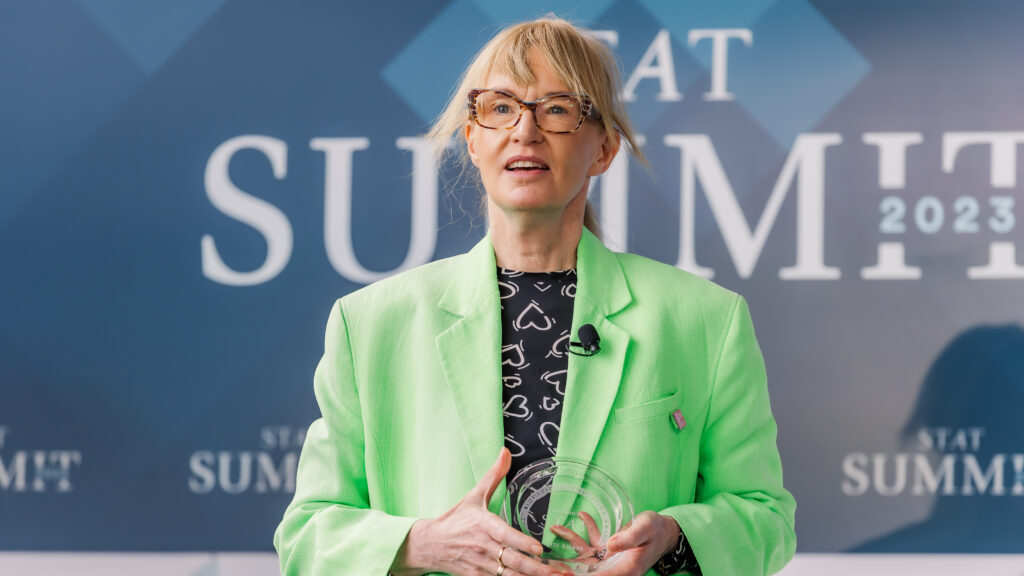Back in the 1990s, scientist Lotte Bjerre Knudsen was tasked with revitalizing a floundering program at Novo Nordisk that had been trying to harness the newly-discovered GLP-1 hormone into viable diabetes drug candidates.
At the time, many of Knudsen’s bosses had already lost hope for the program. Novo’s focus, after all, was on insulin, and the naturally occurring GLP-1 hormone had too short a half-life to use as a drug.
advertisement
But Knudsen continued to see potential in treating not only diabetes, but also obesity, with drugs based on GLP-1, she said Wednesday during the STAT Summit in Boston. “I was always the one saying, ‘don’t forget about GLP-1’ and challenging decisions at the company.”
Eventually, she found a way to make a long-acting analogue of GLP-1 that came to be liraglutide, the ingredient in the diabetes drug Victoza and later the obesity drug Saxenda. That paved the way for Novo to develop an even more powerful GLP-1 analogue called semaglutide, the ingredient in what’s now become blockbuster treatments Ozempic and Wegovy.
With the work and perseverance of Knudsen, Novo’s latest drugs are revolutionizing how doctors treat obesity and spawning an entire industry of drug makers pursuing weight loss drugs — a market that some analysts predict could grow to $100 billion by the end of the decade.
advertisement
It’s also helped make Novo a much more well-known name. Knudsen said that when she visited the U.S. in the ’90s from Denmark, “no one knew what the company Novo Nordisk was. They were all just saying, ‘Oh, are you from Novartis?’”
For her contributions to this new generation of treatments, Knudsen was named the recipient of STAT’s 2023 Biomedical Innovation Award.
STAT recently sat down in an exclusive interview with her to discuss her upbringing in the Scandinavian countryside, her start in science making laundry detergents and her decades of work on GLP-1 medications.
As researchers continue to probe the effects of GLP-1 drugs, the treatments could turn out to have many more benefits beyond lowering blood sugar and cutting weight. They’ve recently shown to reduce the risk of cardiovascular complications, and may also have potential in helping curb addictions and even treating Alzheimer’s.
Knudsen said her interest in Alzheimer’s started when she was studying the effects of GLP-1 drugs on the heart. She saw that the treatments helped lower blood pressure and address other cardiovascular risk factors by regulating inflammation, leading her to hypothesize that the medications may also help alleviate inflammation in the brain and address Alzheimer’s. Novo Nordisk is now studying the use of semaglutide in Alzheimer’s patients in a Phase 3 trial.
Going forward, she sees potential in using proteomics and metabolics, the large-scale studies of proteins and metabolites, to figure out whether GLP-1 drugs could have utility in even more diseases.
Though Knudsen faced a lot of pushback on the GLP-1 program early on, she said she’s glad to have spent her career at a large pharmaceutical company, where she’s been able to work with large teams to move drugs into the clinic and then to the market. “I hear young people say, ‘I’m not really sure I want to go into industry, because I’m probably not going to have any choices, I’m being told what to do.’ And I would just argue that, well, look at me, right?” she said.
“I’ve had a very interesting career where I’ve always just let myself be guided by the science,” she added. “Whether it was laundry detergents early on or whether it was important medicines later on, I always just let myself be guided by the science.”
STAT’s coverage of chronic health issues is supported by a grant from Bloomberg Philanthropies. Our financial supporters are not involved in any decisions about our journalism.

